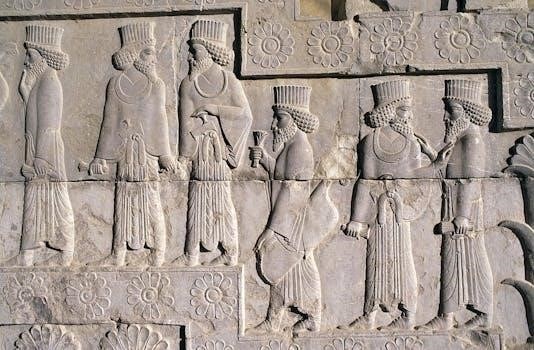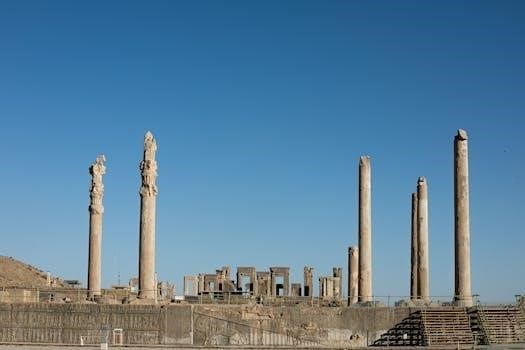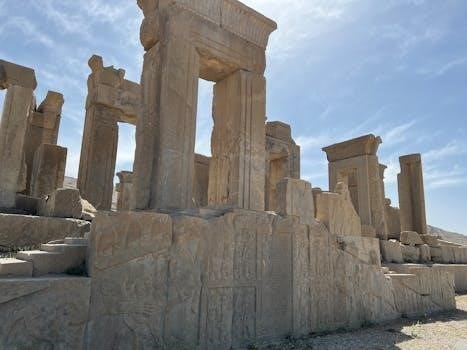Persepolis, a graphic novel by Marjane Satrapi, offers a unique perspective on Iran’s history and culture. Originally published in French, it gained critical acclaim and was compared to Art Spiegelman’s Maus. The narrative explores the author’s childhood during the Iranian Revolution and its aftermath. The book has become a significant work for its insightful portrayal of political and personal turmoil.
Overview of the graphic novel ‘Persepolis’
Persepolis is a compelling graphic novel memoir by Marjane Satrapi, detailing her experiences growing up during and after the Iranian Revolution. The story unfolds through the eyes of a young Marji, an intelligent and outspoken girl from a family with Marxist leanings. The narrative begins in Tehran, where she witnesses the overthrow of the Shah’s regime and the subsequent establishment of the Islamic Republic. Through powerful black-and-white comic strip images, Satrapi skillfully captures the complexities of life in a rapidly changing society. The graphic novel explores the impact of political and social changes on daily life, contrasting the contradictions between home and public life. It portrays the resilience of the human spirit amid repression and the challenges of maintaining personal identity within a restrictive regime. The graphic novel is a blend of personal and political experiences, making it a unique and accessible historical account. The narrative style is both insightful and humorous, offering readers a way to understand a very complex time in Iranian history.

Availability of ‘Persepolis’ in PDF format
The graphic novel Persepolis is widely available in PDF format. Many online sources offer free downloads, making it accessible for educational purposes and personal reading. Numerous sites provide scanned versions of the book.
Where to find free PDF versions of ‘Persepolis’
Locating free PDF versions of Persepolis can be relatively straightforward, given its popularity and educational relevance. Several online platforms and digital libraries often host the graphic novel for download. Websites such as the Internet Archive frequently offer scanned versions of books, including Persepolis, in PDF format. These archives aim to preserve and provide access to a wide range of literature. Additionally, some educational websites and online study resources may also include links to free PDF versions of the book, as they are commonly used in academic settings. It’s worth exploring online forums and communities dedicated to graphic novels or literature, as users may share links to freely available copies. Always ensure that the source you are downloading from is reputable to avoid malware or copyright issues. You may also find some free versions on file-sharing platforms, but their reliability can vary. Remember to be mindful of copyright laws while searching for free PDF versions. Some versions may be for personal use only.

Content and Themes in ‘Persepolis’
Persepolis delves into the Iranian Revolution’s impact, portraying it through a child’s eyes. It explores themes of identity, loss, and the struggle against oppression. The narrative also examines cultural clashes and personal resilience in times of political turmoil.
The historical context of the Iranian Revolution
The Iranian Revolution, a pivotal event depicted in Persepolis, was a complex upheaval that overthrew the Pahlavi dynasty and established the Islamic Republic. This revolution was fueled by widespread discontent with the Shah’s rule, which was seen as autocratic and closely aligned with Western powers. The Shah’s modernization efforts, while aimed at progress, often clashed with traditional Islamic values. Social and economic inequalities also played a significant role, contributing to popular unrest. The revolution saw the rise of Ayatollah Khomeini, who became the supreme leader, and his ideology profoundly shaped the new political order. The revolution had far-reaching consequences, impacting not only Iran but also the broader Middle East, and remains a crucial historical event to understand the context of Satrapi’s narrative, portraying the transition from a secular to a theocratic state and the drastic changes in Iranian society.
Marjane Satrapi’s personal experiences as a child
In Persepolis, Marjane Satrapi vividly recounts her childhood experiences growing up in Tehran during the Iranian Revolution. As an intelligent and outspoken child, she grapples with the rapid changes in her society. She navigates the bewildering contradictions between her progressive home life and the increasingly restrictive public sphere. Her family’s involvement in leftist politics and their opposition to the Shah’s regime shape her early understanding of the world. Satrapi’s narrative details her interactions with family, friends, and neighbors, providing a personal perspective on the impact of the revolution on daily life. She also experiences the shift in cultural and social norms, including the imposition of Islamic dress codes, and the effects of war with Iraq. Through her eyes, the reader witnesses the loss of freedom, the rise of religious fundamentalism, and the effects of political violence on ordinary people.
The impact of political and social changes on daily life
Persepolis vividly illustrates how the Iranian Revolution and subsequent political changes dramatically altered daily life. The overthrow of the Shah’s regime and the rise of the Islamic Republic brought strict social rules. The implementation of mandatory veiling for women, the closure of co-educational schools, and the suppression of personal freedoms are portrayed through Marjane’s experiences. The graphic novel shows how these changes affected her family and community, creating a stark contrast between pre- and post-revolution Iran. Furthermore, the war with Iraq brings further disruptions, with air raids, rationing, and the constant threat of violence becoming part of everyday life. The narrative captures the uncertainty, fear, and resilience of ordinary Iranians as they struggled to adapt to these profound changes. The personal stories emphasize the emotional toll of political upheaval on individuals.

Reception and Critical Acclaim
Persepolis garnered widespread praise for its unique storytelling and insightful portrayal of life in Iran during the revolution. Critics have lauded Satrapi’s ability to blend personal narrative with historical context, making it a universally relatable story.
Comparisons to Art Spiegelman’s ‘Maus’
Persepolis is frequently compared to Art Spiegelman’s Maus due to their shared use of the graphic novel format to explore serious, often traumatic, historical events. Both works employ black-and-white illustrations, which contribute to their somber tone and emphasize the gravity of the subjects they tackle. Like Maus, which uses animals to represent different groups during the Holocaust, Persepolis uses a straightforward, yet powerful, visual style to depict the complexities of the Iranian Revolution. These graphic novels are not just stories; they are historical records that engage readers emotionally and intellectually. Both challenge the conventional understanding of war and its long-lasting effects on individuals and families. Maus and Persepolis elevate the graphic novel medium by demonstrating its capacity to convey complex narratives that are both deeply personal and universally relevant, cementing their place in literary and historical studies. They each demonstrate the potential of the graphic novel as a powerful form of storytelling, able to tackle difficult and sensitive subject matter with nuance and impact.

‘Persepolis’ as a Tool for Education
Persepolis serves as a valuable educational tool, especially in advanced English courses. Its blend of personal narrative and historical context provides a rich learning experience. The book’s accessibility makes complex topics engaging for students.
Use in advanced English courses
Persepolis is frequently used in advanced English courses due to its compelling narrative and rich thematic content. The graphic novel format makes it an engaging text for students, while also introducing them to the conventions of the genre. The work offers opportunities to explore various literary techniques, such as symbolism, irony, and point of view, enhancing analytical skills. Its historical context provides a platform for discussions about cultural identity, political upheaval, and the impact of revolution on individuals and society. The book encourages critical thinking by prompting students to analyze how Satrapi’s personal experiences reflect broader social changes. Moreover, Persepolis promotes cross-cultural understanding by exposing students to a different perspective on world events. It also serves as an excellent example of memoir writing, allowing students to study the techniques of personal storytelling. This book also offers opportunities to study the use of visuals in storytelling, which is a different angle of analysis.